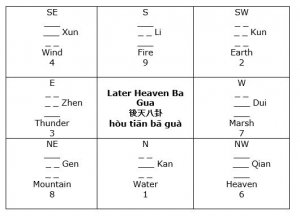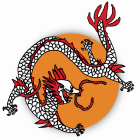Trigrams, Chinese 八卦 bā guà, “eight trigrams”: a trigram is symbol consisting of three lines. The individual lines are either full (yang __) or broken (yin _ _), therefore there are eight combination options forming the basis of the Yijing (易經 yìjīng).
It is said that the eight trigrams were invented by the Chinese Great Emperor Fu Xi which supposedly lived in the 3rd or 4th millennium B. C.
The top line represents the heaven, the middle line the man and the bottom line the earth.
The individual trigrams are called water (Kan), mountain (Gen), Thunder (Zhen), Wind (Xun), fire (Li), earth (Kun), marsh (Dui) and Heaven (Qian). In feng shui, these are assigned to the main directions.
There are to assignment systems, the so called Early Heaven (先天八卦 xiān tiān bā guà) and the Later Heaven (後天八卦 hòu tiān bā guà).
The He Tu and the Early Heaven Ba Gua
The arrangement of the trigrams in the Early Heaven is based on the He Tu (“river map”) which was according to a legend derived from a special pattern on the back of a dragon headed horse seen at the Yellow River.
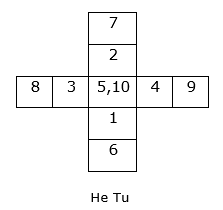
Over time, compass directions had been assigned to the He Tu model:
- on top the hot South and thus the fire with its ascendign energy,
- at the bottom the water and the North with its energy flowing downwards,
- in the East wood with its expanding energy because of the lush green of the Eastern Chinese landscape and
- the West connected with metal because of the metal deposits there.
Reportedly, Fu Xi had combined the He Tu with the trigrams and so construed the so called Early Heaven bagua showing the ideal state of the universe: all opposing trigrams are balancing out perfectly, for example the absolute yang by Qian in the South and the absolute yin in the North by the trigram Kun etc.
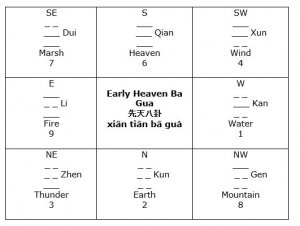
The Luoshu and the Later Heaven Bagua
At the time of the legendary emperor Xia Yu (2123–2025 B C.) a tortoise is said to alight from the river Luo having a pattern of dots in a certain arrangement on its shell. From this the magic Luoshu square has been derived and was combined with the associations of the He Tu:
The Luoshu square
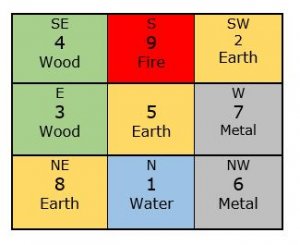
King Wen (1112–1050 B. C.) is said to have combined the bagua model with the Luo Shu resulting in the so called Later Heaven Ba Gua (Hou Tian Ba Gua). This shows the state of imperfection in the universe with its changes in the flow of energy.
